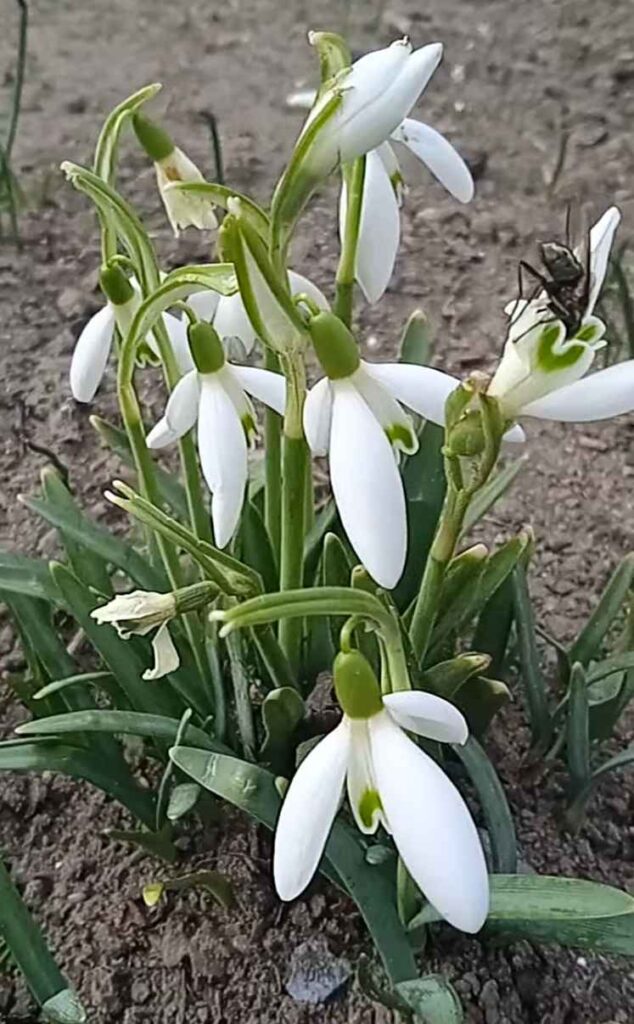At this time of year, spotting the first snowdrops flowers popping up from the cold soil brings a wonderful feeling. These early flowers are a sure sign of the return of spring, as they bravely bloom while frost still lingers. Belonging to the genus galanthus, these delicate white flowers often poke through the snow, their appearance resembling tiny drops of snow, which inspired their name. Snowdrops are small bulbous plants in the Amaryllidaceae family, native to parts of Europe and Asia. Despite their fragile and dainty looks, these tough little flowers thrive in winter, often appearing where few other plants dare to grow.
Also, read my guide on:
Narcissus Flower: Types, Symbolism, and Growing Tips
Taking a walk through woodlands or a quiet meadow as the snow begins to melt away, you may have spotted these charming blooms saying hello to the changing season. Pretty and resilient, snowdrops hold an interesting history and meaning, cherished for their symbolism of hope, renewal, and strength. A guide to their unique beauty often points out how they manage to flourish even in harsh conditions, reminding us that life perseveres in even the coldest winters.
What do snowdrops Flowers symbolize?
1. A Symbol of New Beginnings and Hope
People often associate snowdrops with new beginnings, hope, and rebirth. As the first flowers of spring, they signify the arrival of warmer days and serve as a reminder of resilience and positivity after winter’s challenges.
2. Triumph Over Adversity
Blooming early in harsh conditions, snowdrops represent strength and perseverance. Their ability to thrive despite the cold makes them a symbol of overcoming hardships and embracing change.
3. The Meaning Behind Their White Hue
The pure white petals of snowdrops symbolize innocence, spirituality, and sympathy. This makes them a meaningful gift for those going through life transitions or seeking encouragement.
4. Snowdrop Flowers in Literature and Art
Writers and artists throughout history have admired snowdrops, featuring them in poetry and artistic works. Alfred Lord Tennyson, in his poem The Snowdrop, portrayed them as brave pioneers, standing strong against winter’s bleakness.
5. Etymology and Scientific Origins
The name “snowdrop” originates from Old English, where snaowdropa described their delicate, snow-like form. Their scientific name, Galanthus, comes from the Greek words gala (milk) and anthos (flower), emphasizing their milk-white blooms.
6. A Testament to Strength and Renewal
More than just a beautiful flower, snowdrops symbolize the enduring force of life. From ancient legends to modern celebrations, they continue to inspire people with their resilience and beauty.
7. Snowdrops in Nature and Culture
Whether growing in woodlands, thriving in gardens, or celebrated in festivals, snowdrops bring a sense of optimism and wonder. Their presence in nature serves as a reminder of renewal and the promise of brighter days ahead.
History of Snowdrops Flowers
The history of snowdrops goes back to ancient times when the Greeks and Romans used these flowers for medicinal purposes. During the Middle Ages, snowdrops were often planted in churchyards and linked to the Virgin Mary, representing purity and protection.
People believed these flowers could ward off evil spirits and sometimes wore them as amulets. A Moldovan legend tells the story of Lady Spring, who defeated the Winter Witch in a battle for the Earth’s reign. When Lady Spring’s pricked finger caused the snow to melt, the gentle snowdrop emerged, announcing her victory.
By the Victorian era, snowdrops were highly valued in floral arrangements and decorations, becoming a symbol in the language of flowers for hope and renewal. In the 19th century, they were introduced to North America, where they began to naturalize in gardens and parks, spreading beautifully.
As their popularity grew, horticulturists in the 20th century developed many new cultivars and varieties suited to different garden conditions. This versatility allowed snowdrops to thrive in various landscapes, making them a beloved choice for gardeners.
Scientists began recognizing the role of snowdrops in science and medicine in the 1950s when they discovered the compound galantamine in these flowers. This breakthrough allowed the treatment of Alzheimer’s and other cognitive disorders, further cementing the flower’s importance.
Gardeners, park designers, and flower arrangers have celebrated snowdrops in recent years, showcasing their enduring appeal through beauty, resilience, and historical significance.

Interesting, fun facts about Snowdrops
Did you know that snowdrops are not just beautiful but come with some fun and quirky facts? Many countries, including the UK, consider these flowers endangered and have made collecting them from the wild illegal. Authorities require a special license to transport snowdrops across borders. There are over 2,500 varieties of these delicate blooms, and some rare bulbs can even cost hundreds of pounds, reaching up to £100s!
Snowdrops bloom between January and April, showcasing their beauty in the chill of early spring. What’s even more fascinating is that they contain a substance used to treat symptoms of Alzheimer’s, making them more than just a pretty flower. Their combination of rarity, medicinal value, and seasonal charm makes them a fascinating addition to any garden or conversation.
Where to see snowdrops
Snowdrops are some of the first flowers to bloom in early spring, bringing joy to chilly days. In the Northern hemisphere, you can see them from January to March, while in the Southern hemisphere, they grace gardens between June and August. Their delicate beauty makes them a highlight of botanical gardens and woodlands, where they often create breathtaking displays of large carpets of white blooms. For instance, the Royal Botanic Garden in Edinburgh, Kew Gardens in London, and the New York Botanical Garden are known for their stunning collections of these spring-blooming flowers.
Snowdrops are also found naturalizing in woodlands and parks, where they spread across the undergrowth. Famous spots to admire these blooms include the Ashridge Estate in Hertfordshire, Nymans Garden in West Sussex, and Highgrove House in Gloucestershire. These places offer guided walks and serene views of snowdrops blanketing the ground, making them perfect destinations for nature lovers.
To truly immerse yourself in the beauty of snowdrops, attending one of the many festivals held to celebrate their arrival is a wonderful idea. These events often feature snowdrop-filled walks, talks, workshops, and markets where visitors can appreciate their charm and learn more about their role in welcoming spring.
Final Observations
Snowdrops are a beautiful symbol of hope and renewal, blooming bravely through the coldest days of winter. With their delicate white petals and rich history, these flowers remind us of life’s resilience and purity. Whether found in gardens or woodlands or celebrated in festivals, snowdrops captivate with their charm and enduring significance, offering a gentle promise of spring’s arrival.
FAQs
Q- What do snowdrops symbolize?
Snowdrops symbolize hope, new beginnings, rebirth, purity, and resilience.
Q- What is the myth about snowdrops?
A Moldovan legend says snowdrops were created when Lady Spring defeated the Winter Witch, and her pricked finger melted snow, leading to the first bloom.
Q- What does snowdrop mean in slang?
In slang, “snowdrop” can refer to someone innocent or pure, much like a flower.
Q- Why are snowdrops special?
Snowdrops are special because they bloom early in spring, thrive in winter, symbolize hope, and contain a substance used in Alzheimer’s treatment.
Q- What is a snowdrop called?
The scientific name of a snowdrop is galanthus, derived from Greek words meaning “milk flower.”
Q- What are snowdrops fun facts?
Snowdrops are endangered, have over 2,500 varieties, and rare bulbs can cost up to £100s. They bloom between January and April and thrive in cold weather.










